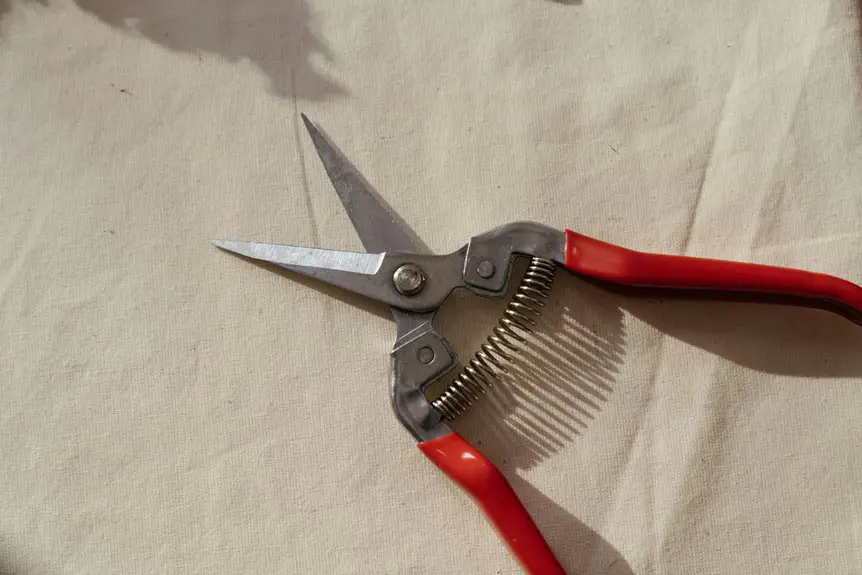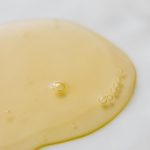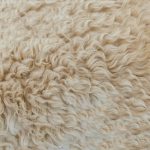To wash polyamide for longevity, start by sorting clothes by color and avoid mixing heavy fabrics. Use cold or lukewarm water (below 30°C), a gentle detergent, and select a gentle cycle. Skip bleach and fabric softeners to protect fibers. Hand wash delicate items if possible, and never wring out the fabric. Air dry flat away from heat and sunlight, and store folded in breathable containers. Follow these steps, and you’ll keep your polyamide looking great—there’s more useful care advice ahead.
Table of Contents
Key Takeaways
- Sort polyamide garments by color and avoid mixing with heavy fabrics to prevent damage and color transfer.
- Wash in cold or lukewarm water (below 30°C) using a gentle cycle and mild detergent designed for synthetics.
- Avoid bleach, fabric softeners, and high spin speeds to maintain fabric elasticity and strength.
- Air dry polyamide flat away from direct heat and sunlight, avoiding tumble drying and wringing.
- Store cleaned garments folded in breathable containers, away from sunlight, to prevent stretching and fiber degradation.
Understanding Polyamide Fabric Properties
Although polyamide may sound technical, you probably know it better as nylon. It’s a synthetic fabric used in everything from sportswear to lingerie because it’s lightweight, strong, and stretchy.
When you wear polyamide, you benefit from its quick-drying and moisture-wicking properties, which help keep you comfortable. However, polyamide can be sensitive to high heat and harsh chemicals, so you need to treat it carefully during washing.
Its fibers resist wrinkles and shrinkage, but they can lose shape if exposed to excessive heat. Knowing these traits helps you choose the right washing settings and detergents.
Sorting Polyamide Clothing Before Washing
Before washing your polyamide clothes, make sure you separate them by color to prevent any bleeding.
Always check the fabric labels for specific care instructions.
Also, avoid mixing polyamide items with heavy fabrics to protect the fibers during the wash.
Separate by Color
Sorting your polyamide clothes by color is essential to prevent dye transfer and keep your garments looking vibrant. You want to keep darks, lights, and colors separate to avoid any unwanted fading or staining. Here’s a simple way to organize your laundry:
| Color Group | Examples | Tip |
|---|---|---|
| Whites | White shirts, socks | Wash in warm water |
| Darks | Black, navy, grey | Use cold water to preserve |
| Brights | Reds, blues, greens | Wash inside out to protect |
| Pastels | Light pink, baby blue | Use mild detergent |
Check Fabric Labels
After separating your polyamide clothes by color, take a moment to check the fabric labels on each item.
These labels provide essential care instructions that help preserve your garments’ quality and prevent damage.
Here’s what to look for:
- Washing temperature – Follow the recommended max temperature to avoid shrinking or weakening fibers.
- Washing method – Some polyamide pieces might require hand washing or gentle cycles.
- Bleach warnings – Avoid bleach if the label advises, as it can degrade polyamide.
- Drying instructions – Some items may need air drying instead of tumble drying to maintain shape and elasticity.
Avoid Heavy Items
Since polyamide fabrics are delicate, you should keep heavy items like jeans or towels separate when washing. Mixing polyamide with bulky, heavier pieces can cause abrasion, stretching, or pilling, reducing your garment’s lifespan.
When sorting laundry, group polyamide with similar lightweight fabrics to protect its texture and shape. Avoid washing polyamide with items that have zippers, hooks, or rough surfaces, as these can snag the fibers.
If you must wash mixed loads, use a mesh laundry bag for your polyamide pieces to add extra protection. Taking these precautions helps maintain the fabric’s smoothness and elasticity, ensuring your polyamide clothes stay in great condition wash after wash.
Choosing the Right Detergent for Polyamide
You’ll want to pick a detergent that’s gentle and specifically designed for synthetic fabrics like polyamide.
Avoid harsh chemicals, as they can damage the fibers and reduce your garment’s lifespan.
Choosing the right detergent helps keep your polyamide clothes looking fresh and strong.
Detergent Types Compatibility
Although polyamide fabrics are durable, choosing the right detergent plays a crucial role in maintaining their quality. Not all detergents work well with polyamide, so you need to be selective to avoid damage or residue buildup.
Here are four detergent types compatible with polyamide:
- Mild Liquid Detergents – Gentle on fibers, dissolve well, and prevent buildup.
- Low-Phosphate Formulas – Protect the fabric’s integrity and color.
- Detergents for Delicates – Designed to clean without harsh agitation.
- Sportswear Detergents – Target sweat and odors without harming synthetic fibers.
Avoid powdered detergents with harsh abrasives, as they may degrade polyamide’s surface.
Always check the detergent label to verify it suits synthetic fabrics like polyamide for the best results.
Avoiding Harsh Chemicals
When selecting a detergent for polyamide, steer clear of harsh chemicals that can weaken the fibers and cause discoloration. Avoid bleach and strong stain removers, as they break down the synthetic material and shorten your garment’s lifespan.
Instead, choose a mild, pH-neutral detergent specifically designed for delicate or synthetic fabrics. These detergents clean effectively without damaging the fabric’s structure. You can also look for labels that mention suitability for sportswear or activewear, which often contain polyamide blends.
Always use the recommended detergent amount—too much can leave residue, while too little may not clean properly. By picking gentle detergents and avoiding aggressive chemicals, you’ll keep your polyamide clothing looking vibrant and intact much longer.
Selecting the Optimal Water Temperature
Because polyamide fibers are sensitive to heat, selecting the right water temperature plays an essential role in maintaining their durability and appearance.
Using water that’s too hot can weaken the fabric and cause shrinking or color fading. To keep your polyamide items in top shape, follow these guidelines:
- Use cold water (below 30°C or 86°F) for most polyamide garments.
- If necessary, opt for warm water (up to 40°C or 104°F) only for heavily soiled items.
- Avoid hot water above 40°C, as it damages fibers and shortens lifespan.
- Always check the garment’s care label for specific temperature recommendations.
Recommended Washing Machine Settings
To protect your polyamide garments during washing, set your machine to a gentle or delicate cycle. This minimizes agitation, reducing the risk of fabric damage or stretching.
Choose a slow spin speed or disable spinning altogether to prevent excessive wear and maintain the fabric’s shape. Use a mild detergent formulated for synthetic fabrics, and avoid bleach or fabric softeners, which can degrade polyamide fibers.
If your machine has an option for extra rinsing, enable it to guarantee all detergent residues wash away. Always wash polyamide items separately or with similar fabrics to prevent abrasion.
Hand Washing Techniques for Delicate Polyamide
Machine washing isn’t always the best option for delicate polyamide garments, especially those with intricate designs or trims.
Hand washing helps protect their fibers and maintain their shape. Here’s how you can do it effectively:
- Fill a basin with lukewarm water and add a mild detergent designed for delicate fabrics.
- Submerge your polyamide item and gently swirl it around for a few minutes—avoid scrubbing or wringing.
- Rinse thoroughly with cool water until all soap is gone to prevent residue buildup.
- Press out excess water carefully by pressing the garment between two clean towels—never twist or wring it.
Following these steps will help your delicate polyamide last longer and keep looking great.
Drying Methods to Preserve Polyamide Quality
When you finish washing your polyamide garment, drying it correctly is essential to preserve its quality and shape.
First, avoid wringing out the fabric as it can distort fibers. Instead, gently press out excess water or roll the garment in a clean towel to absorb moisture.
Next, lay your polyamide piece flat on a dry towel in a well-ventilated area, away from direct sunlight or heat sources, which can cause fading or shrinkage.
Avoid using a tumble dryer, as the high heat can damage the fibers and reduce elasticity. Air drying on a flat surface helps maintain the garment’s form and extends its lifespan.
Storing Polyamide Garments Properly
Although polyamide is durable, how you store your garments greatly affects their longevity. Proper storage prevents damage, maintains shape, and keeps fibers strong.
Follow these tips to store polyamide clothes right:
- Clean Before Storing: Always wash and dry garments thoroughly to avoid mildew and odors.
- Fold Instead of Hanging: Folding prevents stretching, especially for heavier items like jackets.
- Use Breathable Containers: Store clothes in cotton bags or fabric bins to allow airflow and reduce moisture buildup.
- Keep Away from Direct Sunlight: Prolonged exposure can weaken fibers and fade colors.
Tips to Avoid Common Washing Mistakes
Since polyamide requires special care, avoiding common washing mistakes is key to preserving its quality.
First, never use bleach or fabric softeners; they can damage the fibers and reduce elasticity. Always wash polyamide garments in cold or lukewarm water to prevent shrinking and color fading.
Avoid high spin speeds, which may stretch or distort the fabric. Don’t overload the washing machine—give your polyamide items enough room to move freely.
Use a gentle cycle with mild detergent specifically designed for delicate fabrics.
Skip tumble drying; instead, lay your garments flat to air dry away from direct sunlight to maintain shape and color.
Finally, avoid ironing polyamide, but if necessary, use the lowest heat setting and a pressing cloth to protect the fabric.
Frequently Asked Questions
Can Polyamide Fabric Be Ironed Safely?
Sure, if you want to turn your polyamide into a melted mess, go ahead and iron it on high. Otherwise, use a cool setting and a cloth—you’re better off not playing with fire here.
How Does Polyamide React to Bleach or Fabric Softeners?
You shouldn’t use bleach on polyamide because it can weaken the fibers and cause discoloration. Also, avoid fabric softeners since they reduce the fabric’s moisture-wicking ability and damage its elasticity over time.
Are There Specific Brands of Detergent Best for Polyamide?
Think of detergent as a gentle breeze for your polyamide—brands like Woolite or Eucalan work wonders. They clean without harsh chemicals, keeping fibers strong and vibrant, so you don’t have to worry about damage or fading.
Can Polyamide Clothing Be Dry Cleaned?
Yes, you can dry clean polyamide clothing. Just make sure to inform your cleaner about the fabric type so they can use appropriate solvents and processes that won’t damage the delicate fibers, keeping your garment in great shape.
What Signs Indicate Polyamide Fabric Is Wearing Out?
Imagine your favorite workout leggings developing tiny holes after months of use. You’ll notice thinning fabric, pilling, and loss of elasticity—clear signs your polyamide is wearing out and needs replacing to avoid discomfort or damage.
- How to Get Any Stain Out of Polyamide: A Complete Cleaning Guide - June 30, 2025
- Can You Bleach Polyamide? Why It’s a Bad Idea and What to Do Instead - June 30, 2025
- Can Polyamide Go in the Dryer? The Safest Way to Dry Your Garments - June 30, 2025







